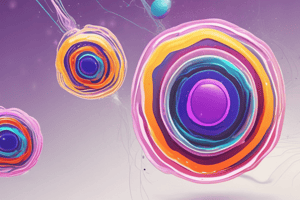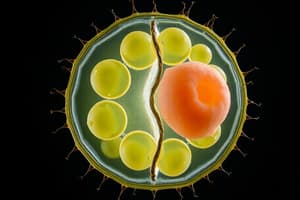Podcast
Questions and Answers
What is a defining characteristic of asexual reproduction?
What is a defining characteristic of asexual reproduction?
- Production of offspring identical to the parent (correct)
- Combination of gametes from two parents
- Involvement of two genetically distinct parents
- Creation of genetically unique offspring
Which process involves the splitting of an organism into two identical parts?
Which process involves the splitting of an organism into two identical parts?
- Fragmentation
- Fertilization
- Fission (correct)
- Budding
In sexual reproduction, what happens during fertilization?
In sexual reproduction, what happens during fertilization?
- Creation of genetically identical offspring
- Formation of new individuals from fragmented pieces
- Combination of gametes to restore full genetic information (correct)
- Production of offspring through budding
Which type of reproduction leads to the creation of more diverse species?
Which type of reproduction leads to the creation of more diverse species?
What is the source of genetic material in gametes?
What is the source of genetic material in gametes?
Which reproductive process involves creating a new individual from a protrusion on the parent organism?
Which reproductive process involves creating a new individual from a protrusion on the parent organism?
Which process involves the fusion of male and female gametes to form a zygote?
Which process involves the fusion of male and female gametes to form a zygote?
In animals, how are sperm transferred to the female reproductive system for fertilization?
In animals, how are sperm transferred to the female reproductive system for fertilization?
Which type of cell division leads to the production of genetically unique haploid daughter cells?
Which type of cell division leads to the production of genetically unique haploid daughter cells?
How do flowering plants transfer pollen from the male reproductive structure to the female reproductive structure?
How do flowering plants transfer pollen from the male reproductive structure to the female reproductive structure?
What is the main purpose of mitosis in cell division?
What is the main purpose of mitosis in cell division?
Which reproductive system facilitates the fusion of male and female gametes to form a zygote in organisms other than animals?
Which reproductive system facilitates the fusion of male and female gametes to form a zygote in organisms other than animals?
Study Notes
Reproduction: Unraveling the Processes of Life's Continuation
Reproduction is the fundamental biological process through which living organisms create new offspring, perpetuating their genetic material and species. This process unfolds in diverse ways, particularly in the forms of asexual and sexual reproduction.
Asexual Reproduction
In asexual reproduction, an organism produces offspring without the involvement of a second parent or fusion of gametes. The resulting offspring are genetically identical to the parent. Some examples of asexual reproduction include fission, fragmentation, and budding.
Asexual Reproduction Examples
- Fission: Organisms split into two identical parts, such as certain algae and flatworms.
- Fragmentation: Pieces of the parent break off, such as in some plants (e.g., some ferns).
- Budding: A new individual develops from a protrusion on the parent (e.g., hydra, some corals).
Sexual Reproduction
In sexual reproduction, two genetically distinct parents combine their gametes (sperm or eggs) to create a unique offspring. The reproductive cells (gametes) contain only half the genetic information of the parent, and they fuse during fertilization, restoring the full complement of genetic information. Sexual reproduction is more common in eukaryotic organisms, and it often leads to the creation of more diverse, adaptive species than asexual reproduction does.
Sexual Reproduction Examples
- Flowering plants: Pollination of the female reproductive structures (carpsels) by male structures (stamens) results in the production of seeds.
- Animals: Male and female gametes fuse in the female reproductive system, forming a zygote.
- Fungi and algae: Sexual reproduction via the fusion of gametes or antheridia and oogonia (plasmogamy) leads to the formation of a zygospore or oospore.
Reproductive Systems
Reproductive systems are specialized structures and processes that facilitate the production and transfer of gametes in an organism. The reproductive systems vary between plants, animals, fungi, and algae, but they all encompass the same basic functions: production, maturation, and transfer of gametes.
Reproductive Systems Examples
- Flowering plants: The male reproductive structure (stamen) produces pollen, which is transferred to the female reproductive structure (carpel) via wind, water, or animals for fertilization.
- Animals: The male reproductive system (testes) produces sperm, which are transferred to the female reproductive system (ovaries) via copulation.
- Fungi and algae: The male reproductive structure (antheridia) produces sperm, which are transferred to the female reproductive structure (oogonia) via secretion or direct contact.
Cell Division
Cell division plays a critical role in reproduction, as it generates the new cells required for organism growth and development. Two main types of cell division are involved in reproduction: mitosis and meiosis.
- Mitosis: A process that produces two genetically identical daughter cells from one parent cell, used in growth and development as well as in asexual reproduction.
- Meiosis: A process that produces four genetically unique haploid daughter cells from one diploid parent cell, used in sexual reproduction.
As you've learned, reproduction is a complex and diverse biological process that leads to the continuation of life. Organisms employ a range of strategies and mechanisms to create new life, and these processes are essential for the perpetuation of species.
Studying That Suits You
Use AI to generate personalized quizzes and flashcards to suit your learning preferences.
Description
Test your knowledge on reproduction, including asexual and sexual reproduction, reproductive systems in different organisms, and the role of cell division in the continuation of life. Explore examples of asexual and sexual reproduction processes, along with the functions of reproductive systems in plants, animals, fungi, and algae.




